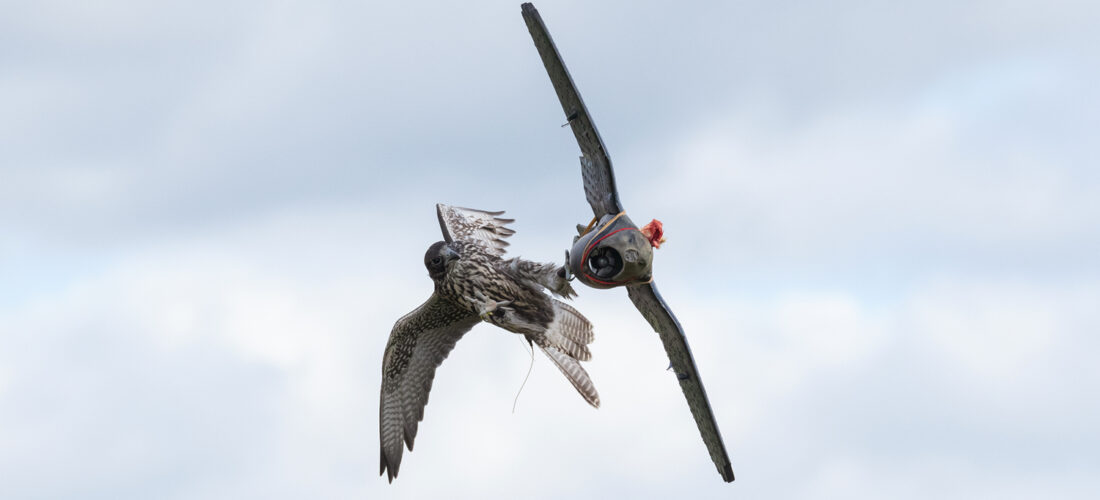An Introduction to Falcon Racing
There are two main disciplines of British Falcon Racing:
- Flat racing.
- Hunt racing.
Flat racing is a timed race over level ground in a straight flight to the lure (tilwah) between a start beam and a finish beam spaced 400 metres apart. Flat Racing is used to determine the fastest Falcon. It is currently practised mainly in the Middle East.
Hunt racing is used to test the Falcon’s hunting abilities. The race starts with a Falcon being unhooded and chasing a robotic Roprey into the sky, climbing as quickly as it can until it reaches a pre-set height (normally 120 metres altitude). Once it has reached the set height, the Pilot dives the Roprey. The Falcon must stoop and pursue the Roprey, catch it in the air and land on the ground with it inside a 100 metre square landing area. The fastest Falcon wins.
Additional activities can be promoted by BFRA to encourage new nations and young people into the sport. Additional non-competitive events include: Demonstration days and fun events, falcon handling, flight simulators, Pilot training, aerial combat training, model painting, courses and demonstrations.
Competitions can be held under BFRA rules in any location. National Qualifying races under BFRA rules are advertised on the BFRA website and the results are logged on the online scoreboard. Depending on the numbers of entries in a class, the leading Falcons in each class qualify to go forward to the National Finals.
Breeders in exporting nations can also train Falcons for non-qualifying races in the late summer prior to their birds being shipped. Selling races allow buyers to attend events and study the form of the young Falcons in August and September, or even to send their own Falconers to start the training in the cooler weather.
General Notes. The Falcon Races suit most Falcon species and can be divided into class categories depending on demand. The races have clear start and finish end-points that can be accurately timed without dispute. They also allow electronic recording for post-flight analysis in case of any uncertainty.
A Falcon Race shows a progressive top score as the event unfolds, so that competitors can see what time they have to beat in the event. It also allows BFRA clubs to post their scores on the BFRA online scoreboard. The races can be organised locally by clubs for their own events, but the results can be put forward as ‘Qualifiers’ for a national competition. Falcons that qualify in National Qualifier races can attend a National Finals event and win a National Championship in its class
While Flat Racing tests the level speed of the Falcons, Hunt Racing offers different elements:
- Hunt Racing tests the strength and fitness of the Falcon in the climb, its speed in the stoop and the accuracy of its footing of the Roprey. While a skilled Pilot can help the Falcon to demonstrate this, ultimately the competition is designed to measure the ability of the Falcon as a potential hunter rather than the skill of the Pilot.
- Hunt Racing provides an exciting and varied spectacle for viewers so that it is a fun event to watch and attend, thus maximising day attendees and demand for TV or film recording or livestreaming and hence sponsorship.
- Hunt Racing offers an element of uncertainty. This means that the recorded times of finalists can be several seconds apart, rather than milliseconds, and that an ‘outsider’ has a sporting chance of winning.
- Hunt Racing allows flights to be run in about six minutes, or ten per hour. This enables a significant number of competitors to participate in one day. Flat Racing can run up to 30 Falcons in one hour.
- The Hunt Racing area, being limited to about 200 x 200 metres, with the Landing Square at 100 x 100 metres, allows clubs to participate even if they do not have access to big open spaces.
- Hunt Racing provides different levels of difficulty so that, for example, breeders can showcase young novice Falcons flying at the beginning of the season for buyers to evaluate them. It also provides tougher levels of competition for more skilled or more powerful Falcons.
- In Hunt Racing the Falcon must unhood cleanly and fly without hesitation the moment that the hood is removed. This is what we expect of a hunting Falcon.
- Hunt Races always take place within about 150 metres of spectators and cameramen. This enables film crews to set up cameras in a predictable way for filming action.
- At larger events, the time clock and the GPS track of the Falcon, can be shown live on screen direct from the Timekeeper’s receiver.
- While the body and wings of the Roprey must all conform to the same factory-made format, the colour or species of the Roprey are optional to allow individual preferences of each Falcon, especially those that hunt. The motor and other parts of the Roprey are optional to encourage progress and development in the performance and reliability of the models. Making an engine more powerful does not necessarily confer an advantage, if the Falcon itself is not powerful. If the Roprey gets too far ahead of the Falcon, the Falcon may be de-motivated and slow down. Also a more powerful motor could drain the battery more quickly, potentially leaving the Pilot in difficulties at the end of the flight.
- The model Roprey provides a platform for team colours and logos, and for logos from sponsors. These logos will be fully visible in photos and films of the event. This provides an incentive for sponsors to support a Falcon or team.


